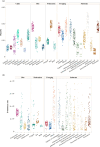Ecological drivers of jaw morphological evolution in lepidosaurs
- PMID: 39657804
- PMCID: PMC11641439
- DOI: 10.1098/rspb.2024.2052
Ecological drivers of jaw morphological evolution in lepidosaurs
Abstract
Ecology is a key driver of morphological evolution during adaptive radiations, but alternative factors like phylogeny and allometry can have a strong influence on morphology. Lepidosaurs, the most diverse clade of tetrapods, including lizards and snakes, have evolved a remarkable variety of forms and adapted to disparate ecological niches, representing an ideal case study to understand drivers of morphological evolution. Here, we quantify morphological variation in the lower jaw using three-dimensional geometric morphometrics on a broad sample of 153 lepidosaur species. Our results suggest that phylogeny has significantly influenced mandibular shape evolution, and snakes have diverged from a lizard-like jaw morphology during their evolution. Allometry and ecological factors like diet, foraging mode and substrate also appear to drive the diversification of mandibular forms. Ecological groups differ in patterns of disparity, convergence and rates of evolution, indicating that divergent evolutionary mechanisms are responsible for the acquisition of different diets and habitats. Our analyses support that lepidosaurs ancestrally use their jaws to capture prey, contrary to the traditional view favouring lingual prehension as ancestral. Specialized or ecologically diverse lineages show high rates of jaw shape evolution, suggesting that morphological innovation in the mandible has contributed to the spectacular ecomorphological diversification of lepidosaurs.
Keywords: Lepidosauria; disparity; ecomorphology; evolution; evolutionary rates; geometric morphometrics.
Conflict of interest statement
We declare we have no competing interests.
Figures





References
MeSH terms
Grants and funding
LinkOut - more resources
Full Text Sources
